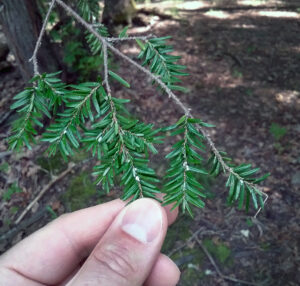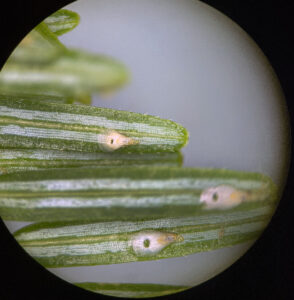
Small, white hemlock woolly adelgid eggs are found on the needles of a tree in Bastian, Virginia, in 2017. / Photo Credit: Bill McNee, Wisconsin DNR
By Mike Hillstrom, Forest Invasive Pest Coordinator, Fitchburg
Michael.Hilstrom@wisconsin.gov or 608-513-7690
Hemlock woolly adelgid (HWA) looms as a major threat to Wisconsin’s hemlock trees. As the infestation of these invasive, aphid-like insects spreads in Michigan and other states in the eastern United States, Wisconsin is preparing to respond when it arrives.
HWA is most evident in winter and spring as fluffy, white, woolly balls that are present at the base of hemlock needles. These fluffy, waxy balls cover adult female adelgids and eggs.
Careful inspection is needed because scale insects, spider egg sacs and a variety of other issues can visually resemble HWA or the damage it causes.

Scale insects such as pine needle scale (above) and elongate hemlock scale can also cause hemlock needle mortality that may be confused with hemlock woolly adelgid infestation. / Photo Credit Wisconsin DNR
Early detection of HWA when it arrives is extremely important, so that infested trees can be removed or treated with insecticide before it spreads. The public is urged to send digital photos of potential HWA sightings to their local DNR Forest Health specialist. Reports can also be sent to the Wisconsin Department of Agriculture, Trade and Consumer Protection Pest Hotline at (866) 440-7523 or datcppesthotline@wi.gov. Posts are also monitored on apps such as iNaturalist and EDDMapS.
Preventing HWA from reaching Wisconsin is equally as important as detection. Wisconsin has an external quarantine to prevent the movement of infested hemlock materials, such as nursery stock and logs with bark, into the state.
The DNR also urges Wisconsinites to take precautions to prevent moving HWA into Wisconsin from infested hemlock in other states. Always use local or certified firewood. If camping, hunting or recreating near hemlock trees, keep vehicles away from them or wash them before traveling elsewhere. Also, wash and dry clothing, boots and other gear that could transport the tiny insects.
